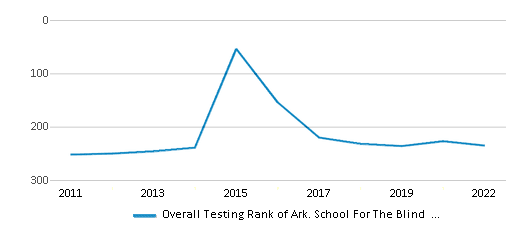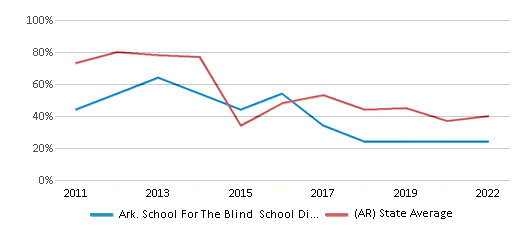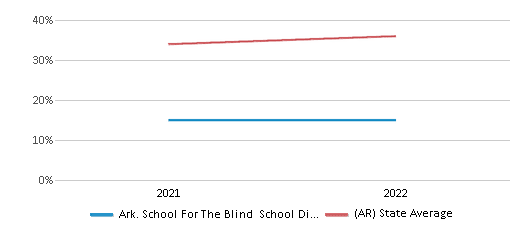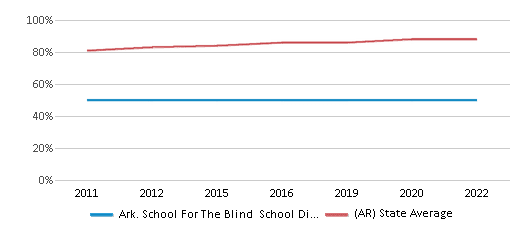Top Rankings
Ark. School For The Blind School District ranks among the top 20% of public school district in Arkansas for:
Category
Attribute
Diversity
Most diverse schools (Top 1%)
Student Attention
Lowest student:teacher ratio (Top 1%)
For the 2025 school year, there is 1 public middle school serving 37 students in Ark. School For The Blind School District. This district's average middle testing ranking is 5/10, which is in the bottom 50% of public middle schools in Arkansas.
Public Middle School in Ark. School For The Blind School District have an average math proficiency score of 20% (versus the Arkansas public middle school average of 36%), and reading proficiency score of 50% (versus the 42% statewide average).
Minority enrollment is 35% of the student body (majority Black), which is less than the Arkansas public middle school average of 41% (majority Black).
Overview
This School District
This State (AR)
# Schools
2 Schools
352 Schools
# Students
67 Students
147,541 Students
# Teachers
27 Teachers
13,335 Teachers
Student : Teacher Ratio
2:1
2:1
District Rank
Ark. School For The Blind School District, which is ranked within the bottom 50% of all 258 school districts in Arkansas (based off of combined math and reading proficiency testing data) for the 2021-2022 school year.
The school district's graduation rate of 50% has decreased from PS% over five school years.
Overall District Rank
#235 out of 259 school districts
(Bottom 50%)
(Bottom 50%)

Math Test Scores (% Proficient)
≤10%
38%

Reading/Language Arts Test Scores (% Proficient)
20-29%
40%

Science Test Scores (% Proficient)
11-19%
36%

Graduation Rate
≥50%
88%

Students by Ethnicity:
Diversity Score
0.58
0.60
# American Indian Students
n/a
846 Students
% American Indian Students
n/a
1%
# Asian Students
2 Students
2,865 Students
% Asian Students
3%
2%
# Hispanic Students
4 Students
21,477 Students
% Hispanic Students
6%
14%
# Black Students
17 Students
28,045 Students
% Black Students
25%
19%
# White Students
40 Students
87,000 Students
% White Students
60%
59%
# Hawaiian Students
n/a
1,533 Students
% Hawaiian Students
n/a
1%
# Two or more races Students
4 Students
5,775 Students
% of Two or more races Students
6%
4%
Students by Grade:
# Students in PK Grade:
-
20
# Students in K Grade:
2
725
# Students in 1st Grade:
4
806
# Students in 2nd Grade:
4
836
# Students in 3rd Grade:
4
826
# Students in 4th Grade:
5
1,120
# Students in 5th Grade:
7
4,995
# Students in 6th Grade:
4
20,844
# Students in 7th Grade:
7
36,641
# Students in 8th Grade:
4
37,270
# Students in 9th Grade:
8
18,603
# Students in 10th Grade:
4
8,958
# Students in 11th Grade:
4
8,347
# Students in 12th Grade:
10
7,514
# Ungraded Students:
-
36
Best Ark. School For The Blind School District Public Middle Schools (2025)
School
(Math and Reading Proficiency)
(Math and Reading Proficiency)
Location
Grades
Students
Rank: #11.
Ark. School For The Blind High School
Special Education School
(Math: ≤20% | Reading: 40-59%)
Rank:
Rank:
5/
Bottom 50%10
2600 W Markham St
Little Rock, AR 72203
(501) 296-1810
Little Rock, AR 72203
(501) 296-1810
Grades: 7-12
| 37 students
Recent Articles

What Is A Charter School?
Explore the world of charter schools in this comprehensive guide. Learn about their history, how they operate, and the pros and cons of this educational innovation. Discover key facts about charter schools, including admission policies, demographics, and funding, as well as what to look for when considering a charter school for your child.

10 Reasons Why High School Sports Benefit Students
Discover the 10 compelling reasons why high school sports are beneficial for students. This comprehensive article explores how athletics enhance academic performance, foster personal growth, and develop crucial life skills. From improved fitness and time management to leadership development and community representation, learn why participating in high school sports can be a game-changer for students' overall success and well-being.

February 05, 2025
Understanding the U.S. Department of Education: Structure, Impact, and EvolutionWe explore how the Department of Education shapes American education, from its cabinet-level leadership to its impact on millions of students, written for general audiences seeking clarity on this vital institution.





